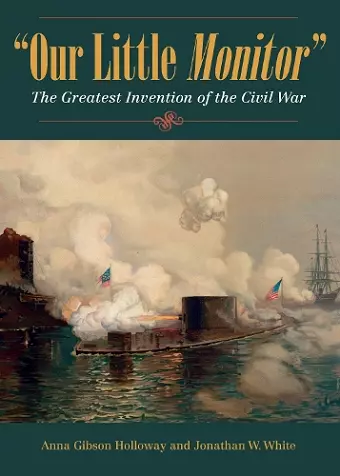Our Little Monitor
The Greatest Invention of the Civil War
Jonathan W White author Anna Gibson Holloway author
Format:Hardback
Publisher:Kent State University Press
Published:15th Feb '18
Currently unavailable, our supplier has not provided us a restock date

On March 9, 1862, the USS Monitor and CSS Virginia met in the Battle of Hampton Roads—the first time ironclad vessels would engage each other in combat. For four hours the two ships pummeled one another as thousands of Union and Confederate soldiers and civilians watched from the shorelines. Although the battle ended in a draw, this engagement would change the nature of naval warfare by informing both vessel design and battle tactics. The “wooden walls” of navies around the world suddenly appeared far more vulnerable, and many political and military leaders initiated or accelerated their own ironclad-building programs.
Americans did not initially have much faith in the Monitor. Few believed that this strange little vessel could hold her own against the formidable Confederate ironclad Virginia, which had been built on the bones of the scuttled USS Merrimack in Portsmouth, Virginia. The Virginia, seemingly relentless and unstoppable, had ravaged the U.S. Navy in Hampton Roads on March 8, just before the Monitor arrived. Yet the following day, the “cheesebox on a raft” proved her Union mettle, becoming a national hero in her own right.
For the remainder of the Civil War the Union Navy used dozens of monitor-style vessels on inland waters as well as at sea. But there would always be only one first Monitor, and she became affectionately known to many throughout the nation as “Our Little Monitor”. Her loss off Cape Hatteras on December 31, 1862, was mourned as keenly in the press as the loss of 16 of her men that night.
Using the latest archaeological finds from the USS Monitor Center in Newport News, Virginia, as well as untapped archival material, Anna Gibson Holloway and Jonathan W. White bring “Our Little Monitor” to life once more in this beautifully illustrated volume. In addition to telling her story from conception in 1861 to sinking in 1862, as well as her recent recovery and ongoing restoration, they explain how fighting in this new “machine” changed the experience of her crew and reveal how the Monitor became “the pet of the people”—a vessel celebrated in prints, tokens, and household bric-a-brac; a marketing tool; and a prominent feature in parades, Sanitary Fairs, and politics.
Holloway and White have . . . done a great service to the historical community in drawing a vast wealth of sources about the ship to the surface. The authors of Our Little Monitor have gone beyond an edited volume and produced an accessible narrative intertwined with primary sources in a way that will give scholars a new depth of detail on circumstances from the ship’s inception to its recovery, and the general reader gets far more than just a glimpse behind the iron plate."- History: Reviews of New Books
"'Our Little Monitor' would look just as at home with lavishly illustrated coffee table books as it would with other important scholarly volumes. It contains well over a hundred full color, detailed photographs that help really solidify how contemporary observers viewed Ericsson's Monitor. Nestled amongst the images are lesser known primary accounts of the Battle of Hampton Roads, songs and poems written about the ship and her crew, as well as drawings and paintings that celebrated the 'Greatest Invention of the Civil War.' This book will undoubtedly set a standard for Monitor research in the future and should be included in any serious historiography. It ought to be considered a "must" for any serious student of the American Civil War and would be an entertaining read to even those with just a casual interest."- Hampton Roads Naval Museum
ISBN: 9781606353141
Dimensions: unknown
Weight: 1275g
304 pages